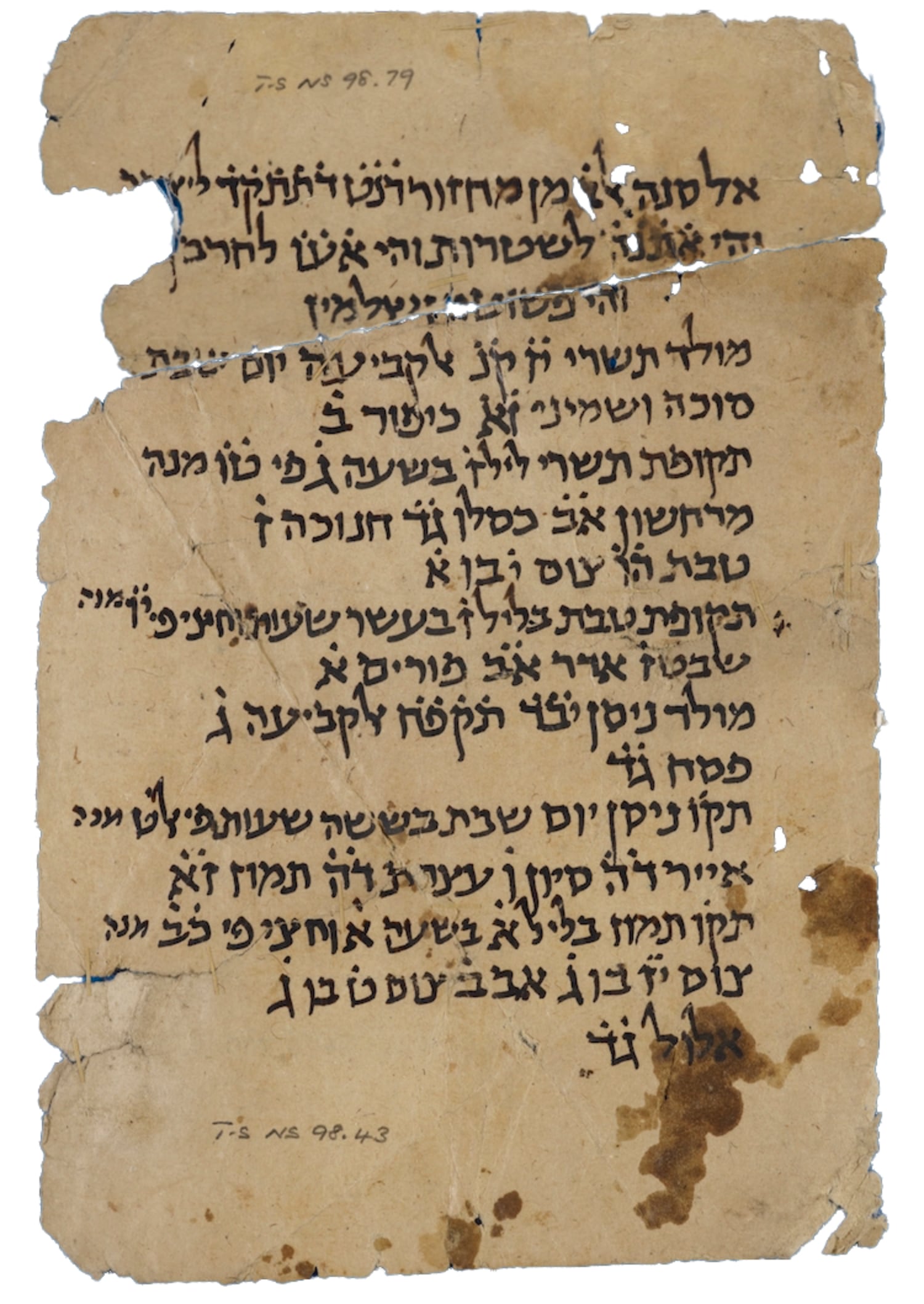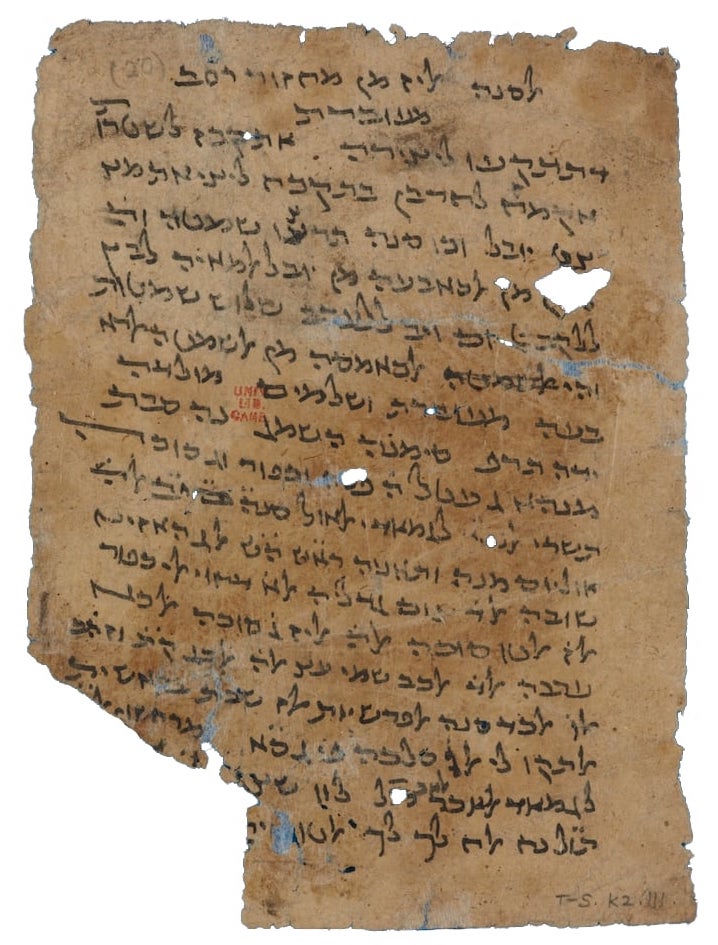Calendar Fragments as a Tool for Palaeography: information and methodology
The objective of this project is to assemble, date and present on a timeline a corpus of datable manuscript fragments on the Jewish calendar from the Cairo Genizah Collection, to serve as a dating tool for palaeography. Very few Cairo Genizah manuscripts are dated: legal deeds and some colophons of books are preserved with dates, but this is a tiny fraction of the tens of thousands of fragments in the collection. A lack of dated or clearly datable texts hampers palaeographic analysis of the manuscripts in the Collection, and further datable sources among the manuscripts are always sought in order to improve the efficacy of palaeographic analysis. One set of texts that are strictly speaking undated, but which can in fact be dated to relatively narrow ranges of dates are calendar fragments.
Genizah calendars as a resource for palaeographic data
The mainstream Jewish calendar is based on a calculation of moladot (astronomical new moons as calculated in the Jewish calendar) of a number of years and applying various other rules, a cumbersome multi-step procedure that requires significant knowledge and numerical abilities. Since the Jewish calendar does not exactly repeat itself until after 689,472 years, the calculation must be carried out on a regular basis and its results cannot be accurately applied to years other than those for which it was performed. The Cairo Genizah has preserved a wealth of calendrical texts, including treatises on the Jewish calendar, polemics between various religious groups over the calendar, auxiliary calculations, and actual calendars themselves. These latter are of two types. Most calendars are based on a calculation of moladot for the years covered by the calendar. A small minority of actual calendars in the Genizah are based on an erroneous assumption that the Jewish calendar repeats itself every 247 years, so that a calendar can be calculated once and reiterated indefinitely.
All calendrical texts reference dates. Calendrical treatises, polemics and reiterative 247-year calendars can be usefully copied at different times, so that the dates they contain do not necessarily reflect their time of copying. On the other hand, due to the lack of repetition in the calculated Jewish calendar, calculated calendars are only useful for the years covered by them. Ephemeral by nature, they can be a small, but useful resource for palaeographic data.
The corpus and its datability
Our corpus of calendars as dating tools for palaeography is made of actual calculated calendars and does not include calendar treatises, polemics between various religious groups over the calendar, or reiterative 247-year calendars. Unlike modern calendars that cover one year only, medieval Jewish calendars usually cover a range of years, most commonly multiples of 19 years (the Jewish calendar follows a 19-year cycle of intercalation in order to bring the lunar months into sync with the solar year). They commonly contain calculated information on the molad of each month of a year and describe in detail the course of each year: its festivals, fasts, days of the week that begin months, etc. Such calendars often circulated as calendar booklets for a small number of 19-year cycles, covering approximately one year per page.

Composite image of T-S NS 98.43r and T-S NS 98.79r, a calendar for the year 1143/4 CE.
The datability of calculated calendars depends on the following considerations. Calculations of moladot are complicated and long winded, and people are unlikely to have performed them for years that had already passed or were in the far future. Non-reiterative calendars based on such calculations were highly unlikely to have been prepared for years far removed from their time of making. Because the calendar does not accurately repeat itself, calendar booklets could not be usefully copied after the time of their coverage either. Hence, the starting date of a calculated calendar booklet most likely reflects the time of the writing of the text, or rather, the 19-year cycle of its writing – because Jewish calendars are most commonly arranged in 19-year cycles, they may cover years within one’s own 19-year cycle even if these years have already passed. One of the clearest demonstrations that years covered by a calculated calendar reflect the time of its copying comes from calendars penned by known scribes, which always fall within the dates of the scribes’ activity known from other sources. For example, all calendars in the hand of the famous court scribe Ḥalfon b. Manasseh, who was active in Fusṭāṭ in first half of the 12th c., cover years between 1104–1160 CE. Calendars in the hand of Yedutun ha-Levi, the cantor of the synagogue of the Palestinians in Fusṭāṭ in first quarter of the 13th c., cover years between 1199–1236 CE.

T-S K2.111v, a calendar for the year 1215/6 CE, in the hand of Yedutun ha-Levi
Dating Genizah calendars
The preserved calendars are dated in various ways. In some, each year is dated according to one or more Eras, both Jewish and non-Jewish (usually Muslim and/or Coptic). In addition to Eras, years are also commonly dated by their position within a particular 19-year cycle. The 19-year cycles are numbered from Creation: cycle 1 stands for years 1-19 of the Era of Creation, cycle 2 for years 20-38 of the Era of Creation, and so on. For example, year 5055 of the Era of Creation can be expressed as year 1 of the 19-year cycle 267. Such dates can co-exist with dates according to specific Eras or be the only method of dating. In many fragmentary calendars, dates are not preserved. If such calendars include moladot (astronomical new moons as calculated in the Jewish calendar), the date can be reconstructed with the help of the Molad Seeker programme developed by Nachum Dershowitz.
For the reasons mentioned above, the starting cycle of a calculated calendar most likely reflects the time of the writing of the text. Because most calendar booklets in the Genizah are fragmentary, it is not always clear however when a particular calendar began. Nevertheless, it is possible to estimate the starting dates of a calendar from the preserved material. In reconstructing calendar booklets in the Cairo Genizah, we discovered that the longest of them cover three 19-year cycles (57 years), although most do not cover more than two (38 years). When dating calendar fragments that do not clearly indicate the range of years in their coverage, we assumed that they originally covered three 19-year cycles. Since calendars must have been copied in or shortly before the first preserved 19-year cycle, this means that the estimated starting cycle falls no earlier than two 19-year cycles before the last preserved cycle and no later than the first preserved cycle: e.g., if the preserved fragment covers the 19-year cycle 267, its estimated starting cycle is between 265 and 267. This means that the calendar can be presumed to have been copied between year 1 of the 19-year cycle 265 (1256/7 CE) and year 19 of the 19-year cycle 267 (1312/3 CE). If the preserved calendar is for the 19-year cycles 267–268, then its estimated starting cycles are 266–267. If it is for 267–269, its estimated starting cycle is 267. The estimated dating of a calendar is roughly equivalent to the range of estimated starting cycles expressed in more usual chronological terms.
Watch ‘Calendars from the Cairo Genizah as a Dating Tool for Palaeography’
A presentation given by Nadia Vidro at the Digital Palaeography and Hebrew/Aramaic Scribal Culture – 2021 International Online Groningen Symposium (6–8 April 2021)
